Another non-discovery of life on Mars?
A team of Greek and British scientists spoke about a new discovery in a Martian meteorite: an ovoid structure that is very similar to a fossilized microorganism.

Over the past two centuries of research on Mars, life has been “found” there more than once. At first, these were well-known "channels", and scientists quite seriously talked about seasonal vegetation cycles along their shores. Later, the space age killed hopes for the discovery of complex life. In the 1970s, the first and last astrobiological experiments on NASA Viking descent vehicles were conducted on Mars. The initial results of the experiments gave encouraging results - nutrient broth began to boil, which could be considered confirmation of the activity of microorganisms, but then revised the results, and came to the conclusion that the cause of the chemically active soil.
The next statement about the found Martian life did not sound from somewhere - but from the threshold of the White House: in 1996, then-US President Bill Clinton told about the discovery, which could become a sensation: in the Martian meteorite, ALH 84001 found something very reminiscent of fossilized bacteria .
')
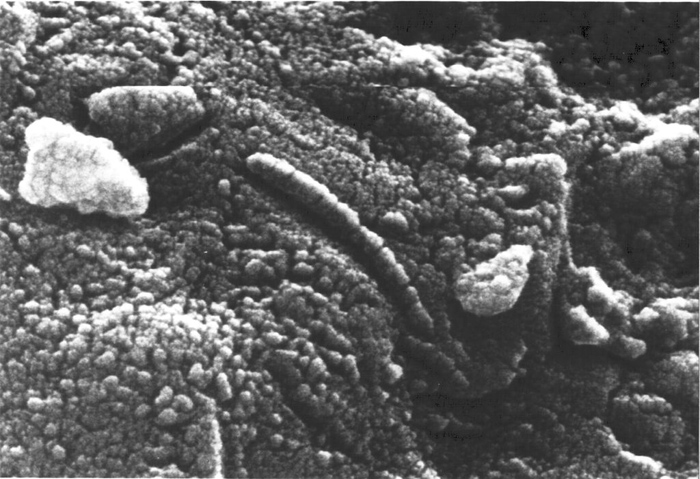
True discovery immediately questioned both American scientists and Russian. The “microbes” found turned out to be too small even for microbes, but they were similar to the natural formations characteristic of volcanic rocks.
Managed to contribute to the hype around the Martian life and the Curiosity rover. It is not equipped with instruments for searching for life, but it can detect hydrocarbons, i.e. organic compounds. In his first detailed geological study in 2012, he found a high content of chloromethanes. However, after analyzing the results, the scientists found that organic matter was found from the earth - from a cracked ampule with a solvent, which was supposed to affect the Martian soil.

The current news came from Europe, and again thanks to a meteorite. Only this is another stone from Mars called "Nahla . " In 2006, it had already been studied under an electron microscope and recognized that there are some hints of signs of petrified life in it. But inconclusive.

After such a verdict, the study of the meteorite did not cease, it was sawed into thin plates and began to study them already. On one of the plates they found some kind of oval structure, which in principle is very similar to a petrified microbe.
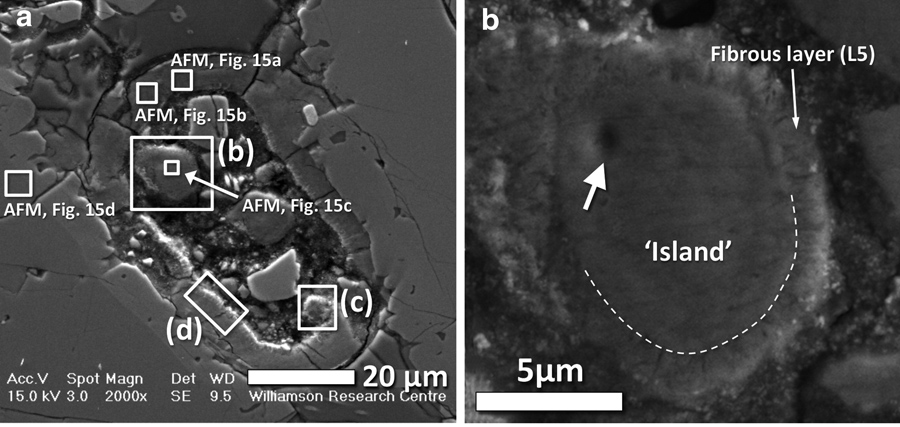
The “microbes” were examined by almost all available methods, determined the chemical composition of each fragment and made up a detailed history of the meteorite itself and the egg-shaped find.
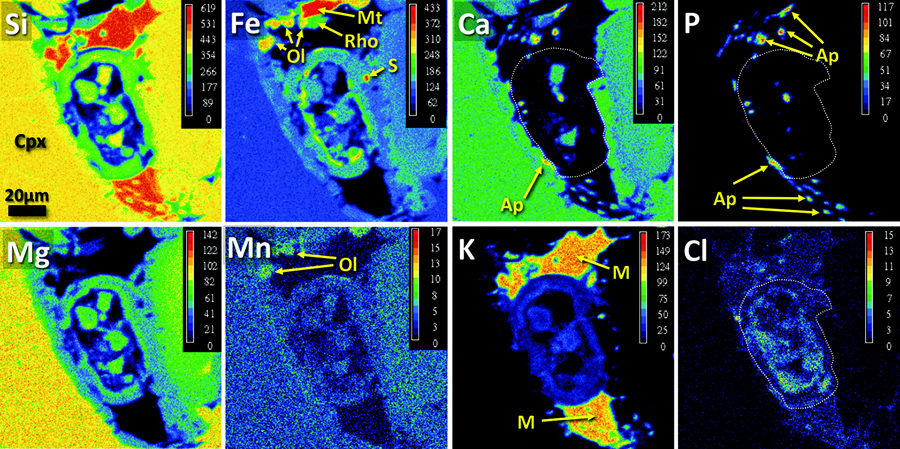
According to the data obtained, the volcanic Martian soil survived about 913 million years ago, a single meteorite impact, which led to an instantaneous heating and sintering of the rock. The second impact occurred 620 million years ago, it melted the permafrost and the water soaked the future meteorite. Around this time, the discovered “egg” appeared in the stone. After that, the stone lay at the bottom of a meteorite crater for more than half a billion years, drying out and cracking. Finally, 11 million years ago another asteroid flew in and hit the surface with such force that the stone not only flew out of the atmosphere of Mars, but also escaped from its gravitational field, setting off on a journey through the solar system. In 1911, the Martian envoy met Earth and fell like a meteor shower in the Egyptian region of Nahla.
The meteorite was picked up almost immediately, so he did not have time to collect earthly living creatures. However, the researchers note that they have identified a lot of factors that allow us to confidently say that the found "egg" definitely arrived "on board" the meteorite.
When examining the “microbe”, scientists were primarily attracted by its shape - it is noted that such regular structures had never been encountered before. For example, the "shell" consists of five layers (L1-L5 in the photo), and inside it are found two bunches, which are also part of the "egg".

Minerals that fill the "egg" have a clayey nature, and are very different from basalt glass, in which they are sharpened. Moreover, one of these minerals, greigite, on Earth has a uniquely biological origin. A study of the place of contact between the oval and volcanic glass suggests that the Martian microbe is not just stuck in a crack, but also managed to bite on pieces of this very glass.
Another intriguing detail is where the "shell" is open (b). The correct symmetry of the rounded joints is surprising.
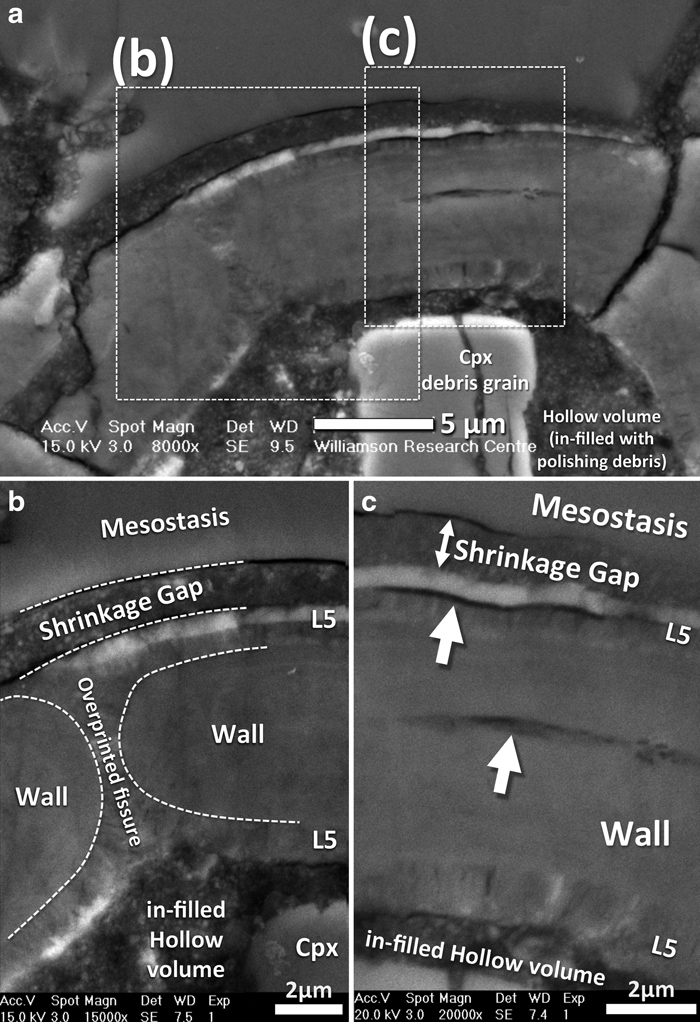
I think if this fossil was found in terrestrial rocks, then no one would even doubt its biological origin. But here is Mars, so scientists have developed as many as three scenarios in which a similar structure could have been formed without the participation of life, but with the participation of water.
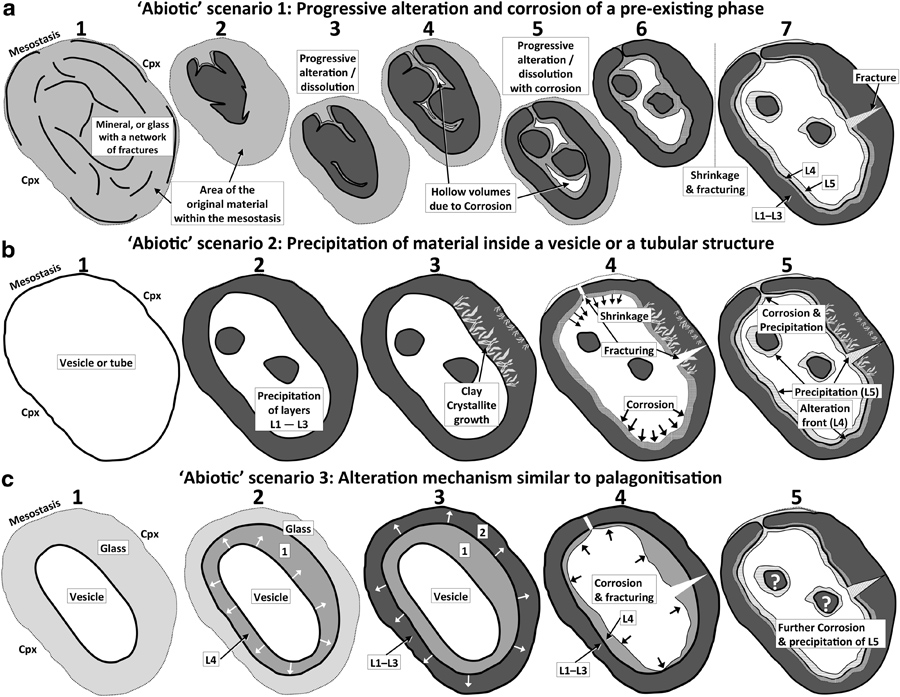
As a result, the researchers conclude: "On the basis of the available data, we have to admit that the formation of the ovoid structure passed without the participation of life."
In my unprofessional opinion: we have one of the most convincing, to date, evidence of the existence of life in the past of Mars. But Occam's razor is merciless to such views: if it is possible to explain the origin without the participation of life, then it did without it. Although I would have consulted with microbiologists, maybe they recognize something familiar in this find?
Now, if they find another such “egg” in the same meteorite or in another Martian, then it will be possible to speak about alien life more confidently. In the meantime, it remains to rely on future Martian missions that can study Mars remotely or bring a handful of stones. But in Russia, the Mars-Grunt project was postponed for the 2030s, and in the United States the Mars Sample Return program is not considered at all - all the money was spent on the MSL-2020 rover. Therefore, all hope for British scientists with microscopes.

Over the past two centuries of research on Mars, life has been “found” there more than once. At first, these were well-known "channels", and scientists quite seriously talked about seasonal vegetation cycles along their shores. Later, the space age killed hopes for the discovery of complex life. In the 1970s, the first and last astrobiological experiments on NASA Viking descent vehicles were conducted on Mars. The initial results of the experiments gave encouraging results - nutrient broth began to boil, which could be considered confirmation of the activity of microorganisms, but then revised the results, and came to the conclusion that the cause of the chemically active soil.
The next statement about the found Martian life did not sound from somewhere - but from the threshold of the White House: in 1996, then-US President Bill Clinton told about the discovery, which could become a sensation: in the Martian meteorite, ALH 84001 found something very reminiscent of fossilized bacteria .
')

True discovery immediately questioned both American scientists and Russian. The “microbes” found turned out to be too small even for microbes, but they were similar to the natural formations characteristic of volcanic rocks.
Managed to contribute to the hype around the Martian life and the Curiosity rover. It is not equipped with instruments for searching for life, but it can detect hydrocarbons, i.e. organic compounds. In his first detailed geological study in 2012, he found a high content of chloromethanes. However, after analyzing the results, the scientists found that organic matter was found from the earth - from a cracked ampule with a solvent, which was supposed to affect the Martian soil.

The current news came from Europe, and again thanks to a meteorite. Only this is another stone from Mars called "Nahla . " In 2006, it had already been studied under an electron microscope and recognized that there are some hints of signs of petrified life in it. But inconclusive.

After such a verdict, the study of the meteorite did not cease, it was sawed into thin plates and began to study them already. On one of the plates they found some kind of oval structure, which in principle is very similar to a petrified microbe.

The “microbes” were examined by almost all available methods, determined the chemical composition of each fragment and made up a detailed history of the meteorite itself and the egg-shaped find.

According to the data obtained, the volcanic Martian soil survived about 913 million years ago, a single meteorite impact, which led to an instantaneous heating and sintering of the rock. The second impact occurred 620 million years ago, it melted the permafrost and the water soaked the future meteorite. Around this time, the discovered “egg” appeared in the stone. After that, the stone lay at the bottom of a meteorite crater for more than half a billion years, drying out and cracking. Finally, 11 million years ago another asteroid flew in and hit the surface with such force that the stone not only flew out of the atmosphere of Mars, but also escaped from its gravitational field, setting off on a journey through the solar system. In 1911, the Martian envoy met Earth and fell like a meteor shower in the Egyptian region of Nahla.
The meteorite was picked up almost immediately, so he did not have time to collect earthly living creatures. However, the researchers note that they have identified a lot of factors that allow us to confidently say that the found "egg" definitely arrived "on board" the meteorite.
When examining the “microbe”, scientists were primarily attracted by its shape - it is noted that such regular structures had never been encountered before. For example, the "shell" consists of five layers (L1-L5 in the photo), and inside it are found two bunches, which are also part of the "egg".

Minerals that fill the "egg" have a clayey nature, and are very different from basalt glass, in which they are sharpened. Moreover, one of these minerals, greigite, on Earth has a uniquely biological origin. A study of the place of contact between the oval and volcanic glass suggests that the Martian microbe is not just stuck in a crack, but also managed to bite on pieces of this very glass.
Another intriguing detail is where the "shell" is open (b). The correct symmetry of the rounded joints is surprising.

I think if this fossil was found in terrestrial rocks, then no one would even doubt its biological origin. But here is Mars, so scientists have developed as many as three scenarios in which a similar structure could have been formed without the participation of life, but with the participation of water.

As a result, the researchers conclude: "On the basis of the available data, we have to admit that the formation of the ovoid structure passed without the participation of life."
In my unprofessional opinion: we have one of the most convincing, to date, evidence of the existence of life in the past of Mars. But Occam's razor is merciless to such views: if it is possible to explain the origin without the participation of life, then it did without it. Although I would have consulted with microbiologists, maybe they recognize something familiar in this find?
Now, if they find another such “egg” in the same meteorite or in another Martian, then it will be possible to speak about alien life more confidently. In the meantime, it remains to rely on future Martian missions that can study Mars remotely or bring a handful of stones. But in Russia, the Mars-Grunt project was postponed for the 2030s, and in the United States the Mars Sample Return program is not considered at all - all the money was spent on the MSL-2020 rover. Therefore, all hope for British scientists with microscopes.
Source: https://habr.com/ru/post/239429/
All Articles